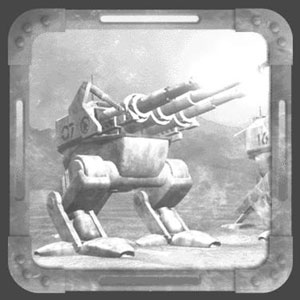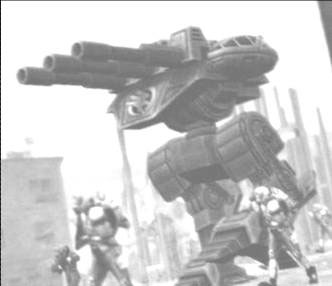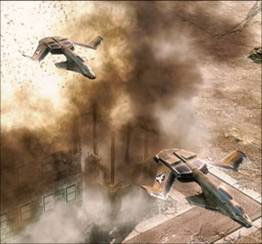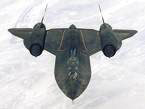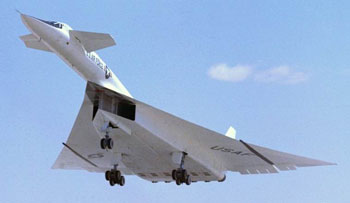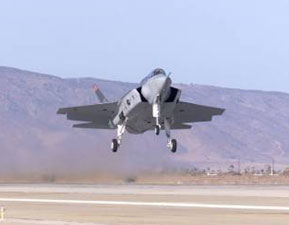
|
Intelligence data updated.
The following is a transcript of a webpage. The original can be viewed here.
|
Sept. 29, 2006
TECHNOLOGY IN 2047
The evolution of technology in the Tiberium universe is one of the hottest topics in the community, and Executive Producer Mike Verdu is here to discuss its impact on Command & Conquer 3 in his second blog posting. Click here to read!
The evolution of technology in the Tiberium universe has been a hot topic. I'm not talking about the shaders, particle systems, AI, and other components of the game engine – instead, I'm referring to the weapons technology used by GDI and Nod in the year 2047. As I've talked to people in the community and watched the activity in the various forums we track, I've witnessed a raging debate about why GDI has seemingly gone backwards in their weapons technology. People are wondering what happened to various exotic technologies and units that made their debut in Command & Conquer Tiberian Sun or Firestorm, including walkers, GDI hovercraft, Nod burrowing units, drones, and cyborgs.
There are two ways to talk about this issue. The first is in terms of fictional continuity.
Let's start with GDI and the current state of their military and weapon systems.
Since the end of the Second Tiberium War (TW2), GDI has been emphasizing containment of Tiberium, ecological recovery, space research, and economic prosperity over preparation for large scale conventional war. For more than a decade, GDI leaders have believed the threat posed by Nod and the rogue AI known as CABAL to be significantly degraded – if not eliminated all together.
GDI's new focus led to a sustained decline in force levels and a decrease in outlays for new conventional weapon systems. At the same time, investment in space programs for both civilian and military use has exploded. GDI has adopted a military strategy that relies on a mix of very high-end weapons and command and control systems in space coupled with cost-effective force projection on the ground. In other words, GDI wants the most advanced technology in orbit supporting ground forces equipped with basic weapon systems that are rugged, reliable, and relatively inexpensive to produce and maintain.
Space technology has raced ahead. GDI forward bases are now equipped with launch capability for drop pods, orbital artillery deployment, and other space-based weapons and intelligence systems. Ion Cannon technology has continued to evolve, taking enormous strides in lethality and accuracy. The Earth is ringed with a necklace of next-generation battle stations armed with powerful new Ion Cannons tied into the most sophisticated anti-satellite/anti-missile defense system in history. Ion Cannons can now hit large numbers of moving targets in space and the upper atmosphere as well as on the ground. The brain for this spectacular ASAT/ABM system is currently ground-based given the vast computing and communication requirements. However, a new generation of orbital platforms and space stations are being built with an eye to the future, with the crown jewel of the fleet being a dramatically expanded and upgraded GDSS Philadelphia.
On the other hand, GDI conventional weapons in 2047 seem decidedly low-tech. GDI ground and air forces are equipped with durable, reliable, and maintainable weapons like the tracked Mammoth (Mk III), Predator main battle tank, wheeled Pitbull recon vehicle, Guardian APC, and the latest generation Orca VTOL scout.
So what happened to the older, more exotic vehicles?
GDI walkers from the Second Tiberium War (TW2) were hugely expensive to build and maintain. They were also quite temperamental on the battlefield. The advantages conferred by their all-terrain capabilities were offset by cost, poor reliability, and easily exploited vulnerabilities. The only mech left in GDI service in 2047 is the huge Mk III Juggernaut mobile artillery system – a direct descendant of the Mk I Juggernaut in TW2. The Mk III is based on a Mk II Titan chassis with a new turret and crew pod, upgraded cannons, and a next generation fire control system. Because these vehicles are intended for indirect fire support and are not expected to be on the front lines, the advantages conferred by all-terrain navigation were deemed worthy of the risks.
As for the Mammoth Mk II walker, it has been replaced by the less expensive, more reliable and still very potent Mk III with four articulating treads. GDI commanders can now deploy multiple Mammoth tanks on the battlefield instead of concentrating their forces with just one or two behemoth walkers. Here is a news item on the closure of the Mammoth Mark II assembly line:
| Discontinuation of the Mammoth Mk II Walker |
| Excerpt from INN Holobrief, March 12th, 2039 |
| It was a sad day for many in Los Angeles today as the last Mammoth Mark II walker to enter active duty clanked its way out of GDI's San Pedro war factory and into history. With its twin rail guns, battlefield dominance, and unusual, boxy profile, the Mk II became an iconic symbol of freedom during the Second Tiberium War. Closure of the Mk II production line has been greeted by many with anger, notably Col. Nick "Havoc" Parker, retired war hero, popular conservative pundit and noted proponent of the "Kane lives" theory. Said Parker:
The Mark II was and continues to be one of our most powerful tools in the war against Nod fanaticism. The discontinuation of the Mark II is nothing but another disgusting example of GDI bureaucratic penny pinching and namby pamby 'can't we all get along' liberalism… once again, GDI is playing right into Kane's hands While protests were held at containment areas several miles away, the mood at the factory was more resigned than angry. Production of the less expensive - but controversial – four-tread Mark III is scheduled to take place in far off Reykjavik, with many in San Pedro fearing for their jobs and the future of their community… |
Hover technology proved to be another seeming dead end for GDI. The advantages of speed and all-terrain navigation were balanced by sky-high costs, poor reliability, damage incurred during “ground strikes” whenever the propulsion systems shut down unexpectedly, and a stubborn vulnerability to Ion Storm activity.
As for drones, the dream of separating human beings from their weapon systems proved elusive. The AI brains piloting unmanned combat aircraft and drones were never a match for vehicles and systems with a human in the loop supplementing AI control; also, the unmanned systems were quite vulnerable to ground-based countermeasures. Any attempt to keep the brains on the ground (such as remote controlled aircraft like today's Predator drones and other UAVs) was thwarted by increasingly sophisticated jamming of the control signals by Nod special forces. Research continues into unmanned systems, but in 2047 the majority of GDI combat aircraft and ground vehicles have human crews.
The Firehawk fast attack jet is a new GDI weapon system that combines the best of AI and human control. The Firehawk is a dynamically unstable airframe that requires computer control to stay in flight – but the resulting air combat performance is unparalleled. The onboard AI also helps pilots with targeting, threat assessment and tracking, weapon control, and navigation. The AI and the pilot work together seamlessly, combining the best of computer and human being.
Firehawk Fast Attack Jet
Dynamically unstable, AI controlledUnlike GDI – which has tried to have it both ways with weapons technology - the Brotherhood of Nod has been preparing for the Third Tiberium War (TW3) for many years.
They have continued to experiment with advanced technology in a variety of areas and have a number of exotic weapons in their arsenal as a result. The most visually interesting Nod weapon system is the Avatar.
Nod has rocketed ahead of GDI in the race to build mechanized combat walkers – solving many of the problems that had GDI engineers scratching their heads. There is speculation that Nod stole the original walker technology from GDI, then took advantage of research in other areas to accelerate the development of new mech prototypes. Regardless of the origin of Nod's technology, they have invested years of research and development at a ruthlessly fast pace – and now Nod has finally fielded a highly advanced bipedal walker with the adaptive ability to use multiple weapon systems.
Nod has also gotten far ahead of GDI in the area of stealth – a constantly escalating race between the technology to conceal and the technology to detect. This race started in the early 1990s and continues apace in 2047. Nod has deployed new stealth tech to conceal everything from an individual unit to a collection of structures; the new technology thwarts all but the newest and most capable GDI sensors. Nod is also fielding systems that are able to spoof GDI sensors, creating duplicate radar images, visual mirages that fool the eye, and other artifacts of a new generation of information warfare.
The gap between Nod and GDI in energy weapons has gotten larger than ever. While GDI works to incrementally perfect the Ion Cannon technology, Nod has focused on weaponry that can be deployed on mobile platforms, including lasers and particle beams. Immediately prior to TW3, Nod has fielded powerful beam cannons on a six-wheeled chassis that are highly mobile and yet lethal at long distances; they can also work together by combining beams and striking over-the-horizon targets with a single coordinated blast of energy.
Exotic Tiberium weapons have always been a Nod strength and their scientists and engineers have been hard at work between TW2 and TW3 on Catalyst missiles that detonate existing Tiberium fields with terrible force, Tiberium seeding bombs that create new Tiberium fields, Tiberium-based toxins, and other exotic Tiberium weaponry that we aren't ready to talk about yet (since it plays an important role in the game story).
Other Nod technologies on display in C&C3 include EMP, limited burrowing (we don't want burrowing to be a widely deployed technology because of the game play implications but we do want to have evidence of the capability on the Nod side), hugely powerful flamethrowers, and psych weapons.
Neither GDI nor Nod has vigorously pursued cyborg research other than to try to wire humans more closely to their machines (like the neural link between a Firehawk pilot and his aircraft or the “virtual sensory pod” that surrounds the Avatar controller). Engineers on both sides have an aversion to the more grotesque man/machine hybrids because of what happened with Cabal at the end of TW2.
So… that's a quick look at the state of technology for GDI and Nod. The perception that GDI has gone backwards is not quite accurate… and what has happened to GDI in 2047 has a number of real world analogs.
For example, look at the amazing technology on display in the following three weapon systems from the 1960s:
SR71 Blackbird (1962)
Each one of these aircraft pioneered one or more exotic technologies. For example, the F-111 had a variable sweep wing (a “swing wing”) that enabled it to switch quickly between flying low and slow and rocketing along at Mach 2.5. The F-111 was also a sleek, futuristic looking airplane.
Fast forward to today. The F-35 Joint Strike Fighter that is intended to replace most ground-attack aircraft in service seems decidedly pedestrian compared to its futuristic ancestors. It's a very plain looking airplane with angular lines. It hews to its mandate to be cost-effective, reliable, and survivable. And yet its weapon systems are very much 21st century – made so by advances in computers, materials, and software that are not so much evident on the surface.
Or how about another example ripped from today's headlines. Contrast the most sophisticated machine ever made, a magnificent spacecraft that combines multiple exotic technologies from rocket engines to ceramics to onboard computers… with its mundane, low-tech replacement. Yes, the Space Shuttle that first flew in 1981 is a futuristic space plane while the replacement Orion – with an estimated in-service date of 2014 - looks more like a space capsule and launcher from the 1960s.
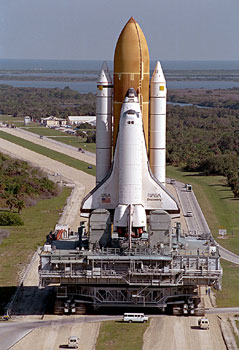 Space Shuttle (in service 1981)
Space Shuttle (in service 1981)
 Orion Crew Exploration Vehicle (estimated in-service date 2014)
Orion Crew Exploration Vehicle (estimated in-service date 2014)
Also, it's worth noting that GDI is hedging its bets for its ground and air forces. At the same time that GDI commanders field their relatively low-tech, trusty, and cost-effective weapon systems, the large network of GDI weapon labs across the Blue Zones of the world are working to keep GDI on the leading edge of technology. A number of black projects are underway in 2047, projects that could yield exotic new weapons that could be fielded within a matter of a few years. Work continues on new generations of walkers and hover technology that address the issues with cost, reliability, and survivability. Completely new technologies are in development as well.
Sometimes this research pays off in ways that benefit existing weapon systems. For example, GDI poured money into railgun research, eventually solving the enormous challenge of powering these deadly weapons so that they can be mounted on most armored vehicles and even carried by heavy infantry. In 2047, rail guns are being widely deployed instead of being limited to huge vehicles like the MkII Mammoth.
After addressing the technology issues on the merits, I'll turn to the second answer to why things are the way they are in 2047. This team has a tremendous passion for C&C and a sensibility that runs more towards the classic tank warfare in the very first Command & Conquer game than the mech-based weaponry in Tiberian Sun. So, we are building the game that we want to play, that we believe in and have great passion for, and that we think is the best expression of C&C. We're asking the fans to trust us to make some decisions about what goes into C&C3. Not everyone will agree with every decision – we understand that. And we'll make some mistakes that the community will call us on and we'll subsequently fix (as we've shown over the last few months). But ultimately we do believe we are on the right track overall, making the right decisions for C&C3 that will give us all a game that is worthy of the C&C legacy. We will back up our decisions with research – and make sure that we don't break the fiction of the Tiberium universe.
Mike Verdu
Executive Producer
Command & Conquer 3
See also
| |||||||||

